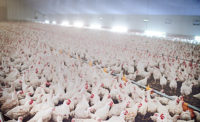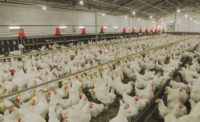Commentary | Poultry Perspectives
Pest-repellent paint: poultry-safe, environmentally friendly

The pest-control technologies currently used for poultry facilities primarily rely on spraying pesticides to disinfect waterers and feeders. Despite its simple implementation, the current spray-based method is limited by multiple factors. Only a nominal percentage of the sprayed pesticide goes directly to the target pest, sprayed pesticide often aerosolizes and can cause respiratory problems to poultry upon inhaling and they can be readily degraded. Gibum Kwon, Ph.D. at the University of Kansas Center for Research, was recently awarded a USPOULTRY grant to investigate how pesticide-embedded paint can overcome these limitations.
Rationale
Because of the absence of a feasible methodology that can enable environmentally safe, sustainable and versatile pest control, the primary focus of this research project is to design and fabricate a pest-repellent paint that resolves the shortcomings of conventional spray-based methodologies. When asked about the approach, Kwon says, “We will introduce a new approach to pest control by developing a pest-repellent paint that is referred to as EPC paint.”
An innovative approach
The proposed pest-repellent paint may resolve the limitations of current pest control approaches. EPC paint is made with all plant-derived green materials. Pesticide degradation in an ambient environment has long been a challenge that has resulted in detrimental economic consequences. The proposed EPC paint may contribute to economic profitability by providing sustained and reliable pest control with long-term efficacy. Current anti-pest methodologies control pests by relying on either repelling or exterminating. A methodology that enables both approaches simultaneously would maximize the pest control aptitude. The researcher thinks the EPC paint can address this challenge by introducing an adjustable formulation that enables versatile pest control.
What are the expected outcomes?
The EPC paint should demonstrate a sustained pest-repellency that can endure for at least 24 months. This will be a significant improvement over the currently used pesticides with relatively shorter service life, because of their susceptibility to degradation and weathering. The pest-repellency demonstrated by the EPC paint should show effectiveness against a wide range of pest species in poultry facilities, including ants, ticks, mosquitos, flies, etc. “We expect the findings of this study will ultimately contribute to economic growth and environmental protection,” Kwon says.
Potential industry benefits
The proposed EPC may benefit the sectors of the poultry industry that are involved in production, such as poultry breeding, hatcheries, feed services in addition to benefitting the processing sectors such as meat and egg processing and packaging. It also will benefit the designers, manufacturers and suppliers of specialized poultry equipment and housing. The “green” chemistry of the EPC paint complies with the strict regulations on environmental protection, which reduces the regulatory burdens on the poultry industry. This will reduce the final costs in all sectors and will also act as a financial incentive to private parties for further investments in developing the infrastructures in the poultry facilities. The long-term durability and efficacy of EPC paint can compensate for both financial loss due to material wastage and degradation. NP
Looking for a reprint of this article?
From high-res PDFs to custom plaques, order your copy today!









